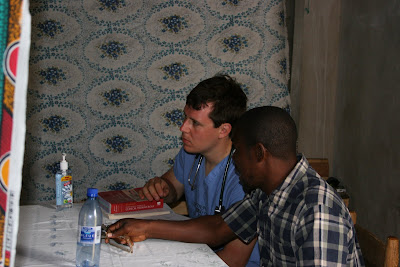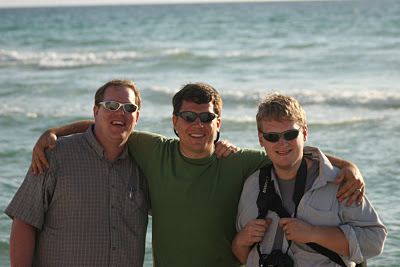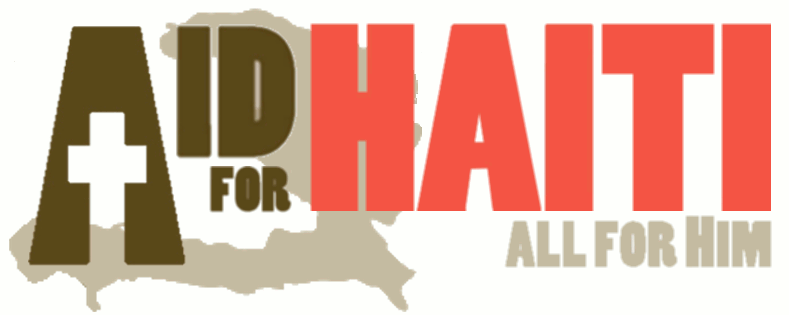This is a map of Haiti. The western third of the island (Hispanola) was given to the French many years ago, so the people, now independently governed for 200 years, speak a form of Creole; the Dominican Republic on the eastern half of the island speaks Spanish. Approximately 8 million people reside on this island which is just larger than Maryland. The average life expectancy in Haiti is 57 years compared to 77 years in the US. Approximately 2/3 of the people lack formal jobs and the majority of the population is unskilled labor. In Port Au Prince (see photo below), 3 million people reside in a small costal town. The favorite mode of public transport is a tap-tap (a converted Datsun or Mitsubishi truck that people, sometimes up to 14, tap on twice for a ride…hence the name).
Thankfully, we didn’t have to ride in the tap-taps, but had a vehicle with a driver instead. At our fullest point of the trip, we had 14 people in the back of this Toyota Hilux…I ended up on the roof of the cab at one point. Riding through the mountains like that will certainly increase your faith…
Catholicism is prevalent in Port au Prince, but over half of the island’s people, regardless of formal religion, practice voodoo. In fact, we got to Haiti one day before the biggest voodoo celebration day of the calendar. Spiritual darkness is evident from many accounts, but so also is poverty. Over 80% of the population is considered below the poverty line and about half are considered to live in abject poverty. This is more evident in the city where crowding and cleanliness are major issues.
But if you only saw PAP you would have a skewed view of this island nation. Much of Haiti is rugged mountains, and the land in the rain shadow of some mountains, can be very dry. Because the land is so rugged and the nation so poor, well-maintained roads are few; this makes travel time-consuming.
Sugarcane used to be a major export when Haiti was still a French colony and along the way to the first village, we drove through some lush bottowland where Haitians still grow sugarcane.
The photo below is the river bed we drove in for two and a half hours on our way to the first village. We ended up only one ridge away from the top of the farthest mountain you see in the photo (the highest mountain in Haiti at about 8000 feet above sea level).
At one point up the infamous riverbed, Elliott and I had to take a photo just to break up the monotony of the bumps. I was on the cab roof at this point. Thankfully, the river bed was mostly dry on the way in, but it was noticeably more wet on the way out.
This is how our luggage and supplies for clinic got over the two mountains we had to climb. We were thankful for the lowly burros and their sure feet.
Unfortunately, we had a limited number of animals, so the believers and some villagers volunteered to carry our equipment for us. As it was, us Americans were busy enough trying to hike this “hills”, but the Haitians just took it all in stride as they waited for us to struggle our way through to the village.
This the first village (see below) that we stayed at for two days. The believers there went far above our expectations in their hospitality, warmth, generosity and appreciation for our visit. It was so encouraging to worship the same Lord with other believers. Though cultural, language and customs barriers existed (and still do), we have fellowship with God and each other because of the Lord Jesus Christ. I wish I could let you hear the songs we enjoyed while we were there. I wonder if I’ve ever heard such enthusiasm for singing a body of believers.
 These are the two fine fellas I went to Haiti with. We are seen here on Miami Beach in Miami, FL because we stayed in the airport the night we were going to be back in TN when they needed volunteers to stay. Took a bus to the beach the next morning before flying that afternoon.
These are the two fine fellas I went to Haiti with. We are seen here on Miami Beach in Miami, FL because we stayed in the airport the night we were going to be back in TN when they needed volunteers to stay. Took a bus to the beach the next morning before flying that afternoon.  Doing a procedure on a little guy who was our patient. Crude setup, but effective we pray.
Doing a procedure on a little guy who was our patient. Crude setup, but effective we pray.  Listening to a patient tell me about her child. Bruce, a dear brother in the Lord, is serving as my translator. We couldn’t have done anything without the believers who served as translators.
Listening to a patient tell me about her child. Bruce, a dear brother in the Lord, is serving as my translator. We couldn’t have done anything without the believers who served as translators.  This is one of the patients with goiter who we photographed and sampled. Hopefully, we’ll be able to finish this stage of our research soon, identify the culprit and implement treatment for these patients.
This is one of the patients with goiter who we photographed and sampled. Hopefully, we’ll be able to finish this stage of our research soon, identify the culprit and implement treatment for these patients.



Published by